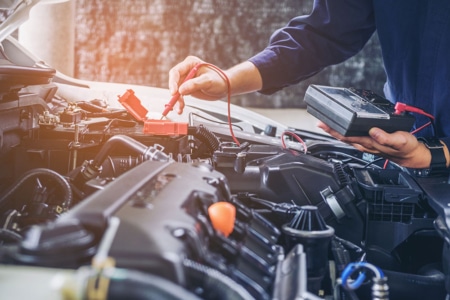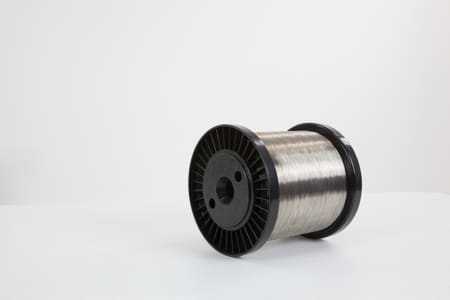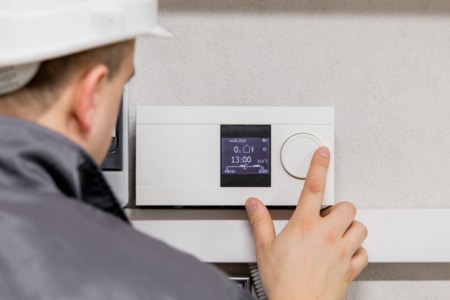Accurately measuring the temperature of aircraft components and the atmosphere you are flying through is vital to maintain both passenger safety and fuel efficiency.
This needs to be carried out across a wide range of temperatures and environments and fed back to the controllers monitoring the aircraft’s systems.
Aerospace Thermocouples:
How are Thermocouples Used to Monitor Temperatures in Aerospace Applications?
By Stephen Holt, Technical Manager since 1996
The Importance of Measuring Temperature
There are two main areas where temperatures need to be monitored:
- For feedback on the physical systems holding the plane in the air, the engines driving it forward and the wings providing lift
- The air conditioning keeping the passengers comfortable (or alive!)
Keeping the Plane Flying
The air the plane flies through provides both the lift that keeps it up and the oxygen to burn the fuel in the engines. The density of this air affects how these processes work and is dependent on both the altitude and the temperature. So, knowing the air temperature is very important for controlling how the plane flies and how much fuel is used.
The International Civil Aviation Organization publish a standard atmospheric model which sets out the baseline for the temperature and pressure of the atmosphere across the aviation altitude range but local weather conditions cause variations which have to be measured on the plane itself.
In aviation nothing is straightforward, even measuring the air temperature. The effect of the kinetic energy of the air passing over an exposed probe and the compression of the air by the plane pushing through it means the temperature the probe records is actually higher than the static air itself (referred to as the Total Air Temperature (TAT)). It is necessary to tap off the air and bring it to a relative standstill over the probe to obtain an accurate, static Outside Air Temperature (OAT). The difference between these temperatures can be 30°C which is important when making decisions about when to switch on anti-ice equipment to prevent ice accumulation on the plane or the fuel from freezing.
The temperature of the components in the engines also require measurement, which is possibly more straightforward, with embedded probes being placed at various points around the engine to ensure the engines are running in the most efficient manner and have not been subject to excessive wear.
Keeping the Passengers Comfortable
The air outside a passenger jet at 32,000 feet is both very cold (around -45°C) and at a low pressure (approx. 1/3 of that at sea level). The cabin air comes from a complex pressurisation, filtration and circulation system that takes air from outside the plane, compresses it, cools it and mixes it with filtered, recycled cabin air. The outside air can be bled off from the first, compressor section of a gas turbine engine or be compressed by a separate pump. This compression actually heats the air to a level that would be dangerous for the passengers so it must be cooled and then mixed with the recycled cabin air before being directed into the cabin.
Where Are Thermocouples Used in Aviation
Base metal thermocouples have a temperature range from -200°C to +1200°C making them perfect for measuring everything from the Outside Air Temperature (-80°C to +55°C) to engine components (-50°C to +1200°C) and the exhaust gases.
Type K Nicro/Nial and Type N Nicrosil/Nisil are the most suitable for these applications as they have the right temperature range and the good corrosion resistance necessary for the harsh environment. Type N is an improved version of Type K but was only created in the 1960s and has taken some time to be adopted.
For the less stringent environment of the cabin air system, resistance-based temperature sensors tend to be used such as thermistors or Platinum resistance thermometers. Here, the change in the resistance of the sensor when it is heated or cooled is used to measure the temperature.
How Does a Thermocouple Work?
When a circuit of two wires of dissimilar alloys is created and the two junctions are placed at different temperatures a voltage is created which is proportional to the temperature difference – the Seebeck effect. Placing a voltmeter at the cold junction allows you to measure this temperature derived ‘emf’ (Electro Motive Force) and hence determine the temperature of the hot junction. This is a robust system and the hot junctions can be embedded in a stainless steel sheath to prevent corrosion of the thermoelement wires.
Type K Thermocouple wires are made from a positive Nickel/Chromium alloy and a negative Nickel/Aluminium alloy. They are suitable for use between -200°C and +1200°C.
Type N Thermocouple wires are made from the same basic elements as Type K but have an addition of Silicon to create Nicrosil (Nickel/Chromium/Silicon) and Nisil (Nickel/Aluminium/Silicon) alloys. The Silicon makes the Type N thermocouple wires less susceptible to hysteresis errors at 400°C, an issue with Type K, and improves their corrosion resistance. However, this is achieved at the loss of some of the generated emf so - Type K thermocouples cannot simply be replaced by Type N, the lead wires also need changing and the measuring equipment needs to be re-calibrated.
Thermocouple Wire Suppliers
Established in 1923, Scott Precision Wire manufactures industry-leading thermocouple wire for use within aircraft temperature monitoring systems. With our years of experience and dedication to perfecting our products, we can offer high-quality aerospace thermocouple wire which has undergone rigorous testing to ensure it is of a premium class.
Scott Precision Wire provides thorough in-process checks and testing to ensure our thermocouple wire is suitable for your applications. Our thermocouple laboratory is devoted to testing against customer EMF specifications.
A custom range of sizes is available, from small sample lengths to full-length reels – all of which is manufactured to the same impeccable standard.
We understand getting your aviation thermocouple conductors right is crucial; that’s why sample product batches are available for sampling and testing before you commit to full production.


